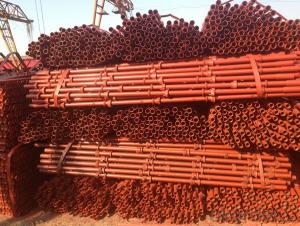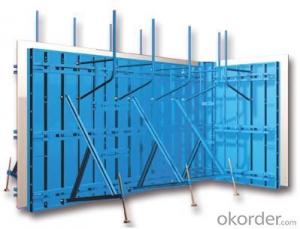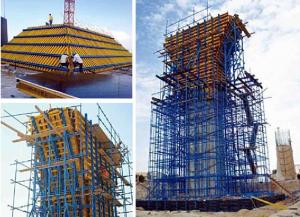Wedge Lock Scaffolding Formwork Aluminum Stair Scaffolding Cnbm
- Loading Port:
- Tianjin
- Payment Terms:
- TT OR LC
- Min Order Qty:
- 10000 set
- Supply Capability:
- 50000 set/month
OKorder Service Pledge
OKorder Financial Service
You Might Also Like
Wedge Lock Scaffolding Formwork Aluminum Stair Scaffolding CNBM
Frame Scaffolding Systems Formwork Bs Standard Scaffolding Tube With Low Price
Developing with new technology materials, steel formworks is no longer a must in construction concrete process. More and more buildings are established with plastic formworks. And workers love this new formworks much more.
The advantages of plastic formworks:
1.First of all--light
Yes it is the first advantage of plastic formwork. It wins the great praise of both contractors and workers.
The biggest panel is 120×1500px,weights 10.5kg only. It can be lift and set up by one person easily, which means there is no need for cranes on site.Saves a lot of cost and time.
2.Easy set up
Different size of panels can firmly locked by simply turn the special handles to 90 degree. The Panels has rib on the back, which makes the system need not traditional wood blocks and nails. The panels have holes to fit tie rod, guarantee the strength of the whole system.
3.Modularity
Modular formworks composed by different size of panels,the main item is 120×1500px panel,which is used for the large area of walls and slabs. There are also small size of panels like 10×1500px,20×1500pxcm,25×1500px,inner corner 20×20×1500px and outer corner 10×5×1500px.Due to the variety of panel size, the system can form almost all size walls 120×1500px panel of multiply by 125px. The material of modular formwork is PC-ABS mixed with special glass fibers which enable panels to hold high pressures.
4.Strength
The handles are made by high strength Nilon, each panel locked by at least 4 handles, which makes the whole system strong enough to pour 1000px walls.
5.Environment friendly
The system needs no cut and nail due to the variety size. Also it needs nearly no wood. The material can be recycled after broken, so it will not pollute the environment.
6.Consequent
Concrete does not stick to plastic formwork, thus the panels need no oil before using, and can be cleaned simply by water. The surface of the wall which build by modular formwork is smooth and without rework.
Wedge Lock Scaffolding Formwork Aluminum Stair Scaffolding CNBM
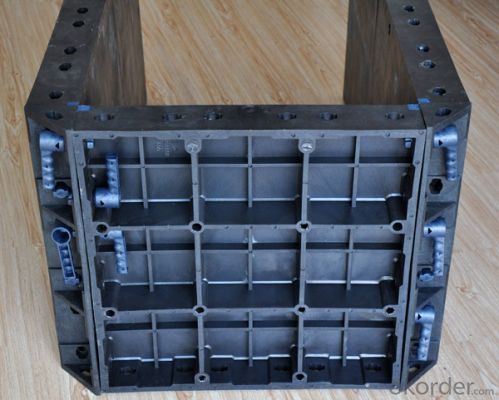
Wedge Lock Scaffolding Formwork Aluminum Stair Scaffolding CNBM
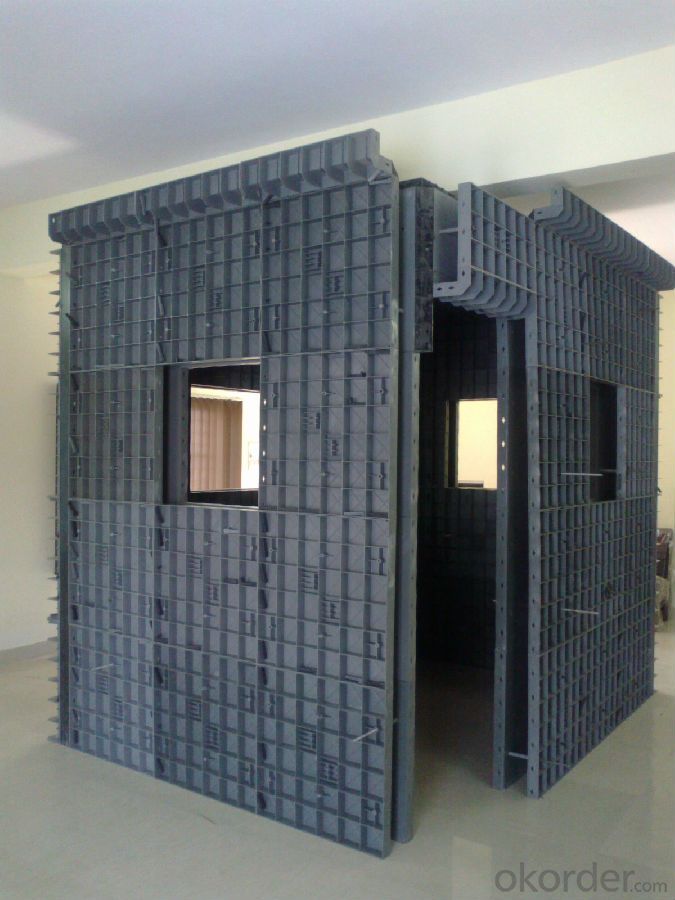
Wedge Lock Scaffolding Formwork Aluminum Stair Scaffolding CNBM

Advantage
* Good loading capacity
* Easy to assemble and dismantle
* Stable and durable thanks to its structual design & automatic welding quality
* Customized solution helps you work safe, save cost and convenient
* Excellent quality for formwork & scaffolding with wide choices
Wedge Lock Scaffolding Formwork Aluminum Stair Scaffolding CNBM
Packing
in bulk or in bundle, or as requested
Shipping
15-20 Days.
Normally small orders, it needs just 15-20 business days to the port. For goods with stock, it would be even shoter.
Wedge Lock Scaffolding Formwork Aluminum Stair Scaffolding CNBM
Other scaffolding & formwork products:
(1) Scaffolding System:
Including Ringlock Scaffolding System and accessories; Cuplock Scaffolding System and accessories; Kwikstage Scaffolding System and accessories; Haki Scaffolding System and accessories;
(2) Scaffolding Frame & Accessories:
Including Walk Through Frame Scaffolding; Ladder Frame Scaffolding; Accessories; we also can make scaffolding according to your samples or drawings.
(3) Scaffolding Couplers/Clamps:
We can produce all kinds of forged and pressed couplers, including British type couplers, American type couplers, German type couplers, Italian type couplers ,fence couplers, BRC coplers and so on. We also can produce according to your drawings or samples.
(4) Formwork System Scaffolding & Accessories:
Light Duty Shoring prop and Heavy Duty Shoring Prop; Wing nuts and Tie rods; RASTO clamp and so on.
FAQ Wedge Lock Scaffolding Formwork Aluminum Stair Scaffolding CNBM
Why Us?
We are one of the Top 500 in the world, largest construction materials supplier in China. Also we are a state-owned company and respond to every customer with large and also small orders.
We own professional manufacturers with powerful producing capacity.
Extensive and comprehensive quality control system
Excellent products with competitive prices.
Efficient services in pre and after sale.
Full energy with affluent experience team.
- Q:How does steel frame formwork prevent the formation of surface defects in the concrete?
- Steel frame formwork is designed to ensure the smooth and accurate placement of concrete during the construction process. It plays a crucial role in preventing the formation of surface defects in the concrete. Firstly, steel frame formwork provides a stable and rigid structure for the concrete to be poured into. This stability prevents any movement or shifting of the formwork during the pouring and curing process. As a result, the concrete is allowed to settle evenly, minimizing the chances of surface defects such as cracks or unevenness. Secondly, steel frame formwork is highly durable and resistant to deformation. Its sturdy construction ensures that it can withstand the pressure exerted by the weight of the concrete without bending or warping. This prevents any potential distortions in the formwork, which could lead to surface imperfections in the concrete. Additionally, steel frame formwork is designed to be smooth and seamless, with minimal joints or gaps. This smooth surface minimizes the likelihood of concrete leakage or seepage, which can cause surface defects such as honeycombing or voids. By effectively containing the concrete within the formwork, steel frame formwork ensures a consistent and defect-free surface finish. Furthermore, steel frame formwork allows for precise control over the concrete pouring process. It can be easily adjusted and leveled, ensuring accurate placement and uniform thickness of the concrete. This precision helps to prevent surface defects such as unevenness or irregularities, resulting in a smoother and more aesthetically pleasing finished product. In conclusion, steel frame formwork prevents the formation of surface defects in concrete by providing stability, durability, smoothness, and precision during the construction process. Its ability to maintain the integrity of the formwork and control the concrete placement ensures a high-quality surface finish without any imperfections.
- Q:What are the different types of accessories used in conjunction with steel frame formwork?
- Some of the different types of accessories used in conjunction with steel frame formwork include tie rods, formwork clamps, formwork nuts, formwork couplers, formwork panels, formwork corners, and formwork supports. These accessories help in ensuring proper alignment and stability of the steel frame formwork system during the concrete pouring and curing process.
- Q:How long does it take to set up steel frame formwork?
- The time it takes to set up steel frame formwork can vary depending on several factors such as the size and complexity of the project, the experience and efficiency of the construction team, and the availability of necessary equipment and resources. In general, setting up steel frame formwork can take anywhere from a few hours to several days. For smaller projects, such as residential buildings or small-scale structures, it may take a day or two to complete the formwork installation. This includes assembling and positioning the steel frames, securing them to the ground or existing structures, and ensuring they are level and plumb. On the other hand, larger and more complex projects, such as commercial buildings or high-rise structures, may require several days or even weeks to set up the steel frame formwork. These projects typically involve a larger number of steel frames, intricate designs, and more detailed planning and coordination. Additionally, the presence of additional elements like beams, columns, and slabs can further increase the setup time. It is important to note that the efficiency and experience of the construction team play a significant role in determining the setup time. Experienced and well-coordinated teams can often complete the formwork setup more quickly and accurately, while those with less experience may require more time. Overall, the time it takes to set up steel frame formwork can vary significantly depending on various factors, but it is essential to prioritize accuracy, safety, and quality during the installation process to ensure a successful and durable construction outcome.
- Q:What are the different types of safety systems used with steel frame formwork?
- There are several types of safety systems commonly used with steel frame formwork, including guardrails, safety nets, edge protection systems, fall arrest systems, and personal protective equipment (PPE) such as helmets, harnesses, and safety goggles. These systems are designed to prevent falls, provide physical barriers, and ensure the safety of workers during construction activities involving steel frame formwork.
- Q:What are the key considerations for selecting the appropriate steel frame formwork system?
- There are several important factors to consider when choosing the right steel frame formwork system: 1. Structural Requirements: It is essential to ensure that the chosen system can handle the load and stresses imposed by the concrete, while maintaining the overall structural integrity. 2. Formwork Design: The design of the formwork should align with the project requirements, considering the shape, size, and complexity of the concrete elements that need to be formed. 3. Durability and Longevity: The longevity and durability of the system are crucial, as they directly affect the project's cost-effectiveness. It should be able to withstand repeated use and exposure to different environmental conditions without significant deterioration. 4. Ease of Assembly and Disassembly: The system should be designed for quick and efficient installation and removal, reducing construction time and labor costs. 5. Safety: Safety is of utmost importance, and the system should be designed with adequate safety features to protect workers during installation and usage. 6. Cost: Cost-effectiveness is always a major consideration, taking into account initial investment, maintenance costs, and the overall lifespan of the system. 7. Availability and Support: It is important to consider the availability of the system and the support provided by the manufacturer or supplier, including technical assistance and guidance throughout the project. To conclude, selecting the right steel frame formwork system requires careful evaluation of factors such as structural requirements, formwork design, durability, ease of assembly, safety, cost, availability, and support. By considering these aspects, one can choose a system that best suits the project's needs and ensures successful construction.
- Q:What are the different types of concrete vibrators used with steel frame formwork?
- Steel frame formwork can be used with various types of concrete vibrators. These include: 1. Internal Vibrators: Commonly known as poker vibrators, these are the most frequently used type of concrete vibrator. They are inserted vertically into the concrete pour and vibrate at high frequencies, increasing the fluidity and compactness of the concrete. Depending on the project's requirements, internal vibrators can be powered by electricity, pneumatic devices, or petrol. 2. Surface Vibrators: These vibrators are employed to consolidate the upper layer of concrete in horizontal applications such as slabs or pavements. They are usually handheld and moved across the concrete surface to ensure proper compaction. 3. Formwork Vibrators: Specifically designed to be attached to the steel frame formwork, these vibrators are often used in large-scale projects where a significant amount of concrete needs to be poured rapidly. Electric or hydraulic-powered, formwork vibrators are mounted on the formwork itself, providing efficient vibration throughout the entire structure. 4. Vibrating Tables: These tables are used to consolidate concrete in precast applications, such as the production of concrete blocks or panels. The concrete is placed on a vibrating table that shakes at high frequencies, guaranteeing compaction and eliminating air voids. The choice of concrete vibrator for steel frame formwork depends on specific project requirements, including the size and thickness of the concrete pour, desired compaction levels, and available power sources. It is crucial to select the appropriate vibrator to ensure proper concrete consolidation and achieve the desired structural integrity.
- Q:How does steel frame formwork contribute to the speed of construction?
- Steel frame formwork contributes to the speed of construction by providing a durable and reusable structure for pouring concrete, which reduces the time and effort required for formwork assembly and disassembly. The steel frame's strength and stability allow for faster and more efficient pouring and curing of concrete, resulting in accelerated construction timelines.
- Q:How does steel frame formwork handle different types of concrete additives?
- Steel frame formwork is a versatile and durable system that can effectively handle different types of concrete additives. These additives are commonly used to enhance specific properties of the concrete, such as strength, durability, workability, and setting time. The steel frame formwork is constructed using high-quality steel, which provides excellent strength and stability. This allows it to withstand the increased pressure and potential chemical reactions that may occur when using concrete additives. The steel frame is designed to support the weight of the concrete and any additional loads from the additives, ensuring that the formwork remains intact during the pouring and curing processes. Moreover, steel formwork is resistant to chemical reactions and corrosion, making it suitable for use with various types of concrete additives. Some additives, such as accelerators or plasticizers, can increase the setting time or improve the workability of the concrete. The steel formwork can handle the increased flowability of the concrete when these additives are used, ensuring a smooth pouring process and proper placement of the concrete. In addition, steel formwork can effectively handle concrete additives that enhance the strength and durability of the concrete, such as fibers or admixtures. These additives can improve the resistance to cracking, shrinkage, and chemical attacks. The steel frame formwork ensures that the concrete maintains its structural integrity and can withstand the additional stresses imposed by these additives. Furthermore, steel formwork can accommodate the use of different types of concrete additives without compromising the quality of the final product. The formwork system allows for easy customization and adjustment to accommodate the specific requirements of each project. It can be easily modified to accommodate the increased flowability or changes in the setting time caused by the additives. Overall, steel frame formwork is a reliable and effective system that can handle different types of concrete additives. Its strength, stability, and resistance to chemical reactions make it an ideal choice for projects that require the use of concrete additives to enhance the properties of the final product.
- Q:Can steel frame formwork be used for architectural and artistic projects?
- Yes, steel frame formwork can be used for architectural and artistic projects. Its strength and durability make it suitable for creating complex and intricate designs, and it can be customized to meet specific project requirements. Additionally, steel frame formwork provides stability and precision, ensuring high-quality finishes in architectural and artistic constructions.
- Q:What are the different types of formwork corner solutions available for steel frame formwork systems?
- There are several different types of formwork corner solutions available for steel frame formwork systems, including adjustable corner brackets, folding corner brackets, corner wedges, and corner connectors. These solutions are designed to provide stability and support to the formwork corners, ensuring precise alignment and efficient construction processes.
1. Manufacturer Overview |
|
|---|---|
| Location | |
| Year Established | |
| Annual Output Value | |
| Main Markets | |
| Company Certifications | |
2. Manufacturer Certificates |
|
|---|---|
| a) Certification Name | |
| Range | |
| Reference | |
| Validity Period | |
3. Manufacturer Capability |
|
|---|---|
| a)Trade Capacity | |
| Nearest Port | |
| Export Percentage | |
| No.of Employees in Trade Department | |
| Language Spoken: | |
| b)Factory Information | |
| Factory Size: | |
| No. of Production Lines | |
| Contract Manufacturing | |
| Product Price Range | |
Send your message to us
Wedge Lock Scaffolding Formwork Aluminum Stair Scaffolding Cnbm
- Loading Port:
- Tianjin
- Payment Terms:
- TT OR LC
- Min Order Qty:
- 10000 set
- Supply Capability:
- 50000 set/month
OKorder Service Pledge
OKorder Financial Service
Similar products
New products
Hot products
Related keywords

